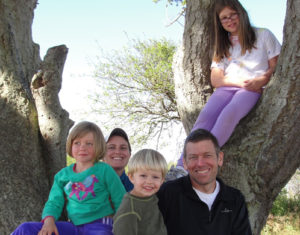Amidst the whirl of a busy life — careers, ailing parents, children’s birthday parties, exercise — there are moments that stand out with startling clarity.
 Jen Wroblewski remembers one such moment. It was two days before her husband, Scott, had a heart attack. He had just shown her how to play backgammon.
Jen Wroblewski remembers one such moment. It was two days before her husband, Scott, had a heart attack. He had just shown her how to play backgammon.
“After we finished the game, he stood up and clutched his chest,” says Jen. “He took a deep breath, and he stared out the window toward Puget Sound. I asked, ‘Are you okay?’ He said, ‘Yeah,’ and then he moved on with his day.”
Two days later, on May 23, 2016, Jen was driving to Spokane to visit her mom, who’d just had surgery. The Wroblewskis’ three-year-old son was in the back seat. A friend called, telling her Scott had fallen down the stairs and medics were giving him CPR. Jen headed back to Seattle, an agonizing three-hour drive. And on the way, she learned that Scott, at the age of 49, had passed away.
A question of timing
When Jen and Scott got married, Jen knew that he had a congenital heart condition called a bicuspid aortic stenosis. She knew that at some point he would need a heart valve replacement. But the couple didn’t know when. “We always thought it would be something we would go through together,” says Jen.
Scott had severe aortic stenosis, but he didn’t have symptoms. For people like him, the risk of undergoing heart surgery is higher than the risk of waiting until symptoms present. So Jen and Scott waited, and they got on with their busy lives.
“Aortic stenosis tends to be a slow, progressive disease,” says David Owens, M.D., M.S., UW assistant professor of medicine in the Division of Cardiology. “It’s a process of many years, possibly decades, when the valve starts to change, impairing the leaflet mobility and creating pressure buildup within the heart.”
Owens, who has been researching aortic stenosis for 15 years, says determining the best time for a valve replacement can be difficult. Ultimately, he says, it’s a disease that could benefit from more research, especially since there are no approved therapies for people with the disease.
Ending suffering
Upon hearing of the family’s tragic loss, Jen’s colleagues at the Northwest Association for Biomedical Research put out a call for donations. Support came pouring in, and Jen decided to donate the gifts to UW Medicine. She hopes the money will advance research on aortic stenosis and shed some light on issues of timing related to valve replacement.
“There have been some great advances in the last few years that have allowed us to replace these valves using catheters and wires as opposed to open-heart surgery,” says Owens. But more work remains, such as figuring out how long those valves will last, especially if used to treat younger people — people like Scott.
Jen has made a career of medical research, including a decade-long stint at Harborview Medical Center, and she has a lot of faith in science. “I really believe in the power of biomedical research to reduce suffering,” says Jen, whose kids were ages 3, 7 and 9 when their father suddenly passed away. Needless to say, they miss him deeply.
“A better understanding of this condition will, hopefully, prevent other families from having to go through this,” she says.
